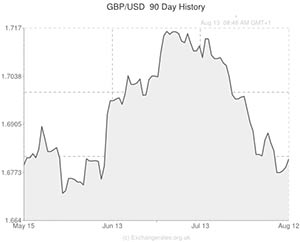
The Pound to US Dollar exchange rate (GBP/USD) broke through psychological resistance at 1.68 yesterday afternoon in the minutes following a jobs report from the United States.
However, it is unlikely that the uptick in GBP to USD was related to the Job Openings and Labour Turnover Survey (JOLTS), which printed at its highest level for 13 years. The JOLTS index is known to be held in high regard by Federal Reserve Chairwoman Janet Yellen, but yesterday’s negative USD reaction to the report suggests that traders don’t think it will have a material impact on the Fed’s rate hike projections.
Today’s dataset is likely to have a much more noticeable impact on the Pound to US Dollar exchange rate.
Unemployment in Britain is predicted to have fallen to a fresh 6-year low of 6.4% during June, which is likely to boost Bank of England rate hike expectations. However, optimism towards Sterling could be curtailed if the average earnings figure drops from a 5-year low of 0.3% to an even more depressing level of -0.1%.
Recent comments from BoE policymakers suggest that the bank is minded to hold back on interest rate hikes until real wages (average earnings minus inflation) start to rise. With inflation currently running at 1.9%, it will take a sizable increase in earnings before real wages move back into the green.
Later on in the morning the BoE is due to release its quarterly inflation report. The data will be scoured for signs of future monetary policy. If the bank upgrades its GDP or inflation projections then that will likely bolster demand for Sterling, but if the report strikes a dovish tone then it could undermine the Pound.
The next key support level for GBP/USD exists at 1.67 whilst the next significant resistance level exists just below 1.69. If either of these barriers is broken then Sterling could continue to trade in the corresponding direction against the ‘Greenback’ over the next few weeks.
Data from the United States is expected to have a much milder impact on the Pound to US Dollar exchange rate.
Business inventories are tipped to have ticked lower from 0.5% to 0.4% in June and retail sales look set to print at 0.2% for July, just as they did for June. In order for the ecostats to have an impact on GBP/USD there will have to be a major upside or downside surprise in the retail sales figure, as this is considered more influential than the inventories indicator.
The Pound Sterling to US Dollar (GBP/USD) exchange rate is currently trending in the region of 1.6826.

Comments are closed.